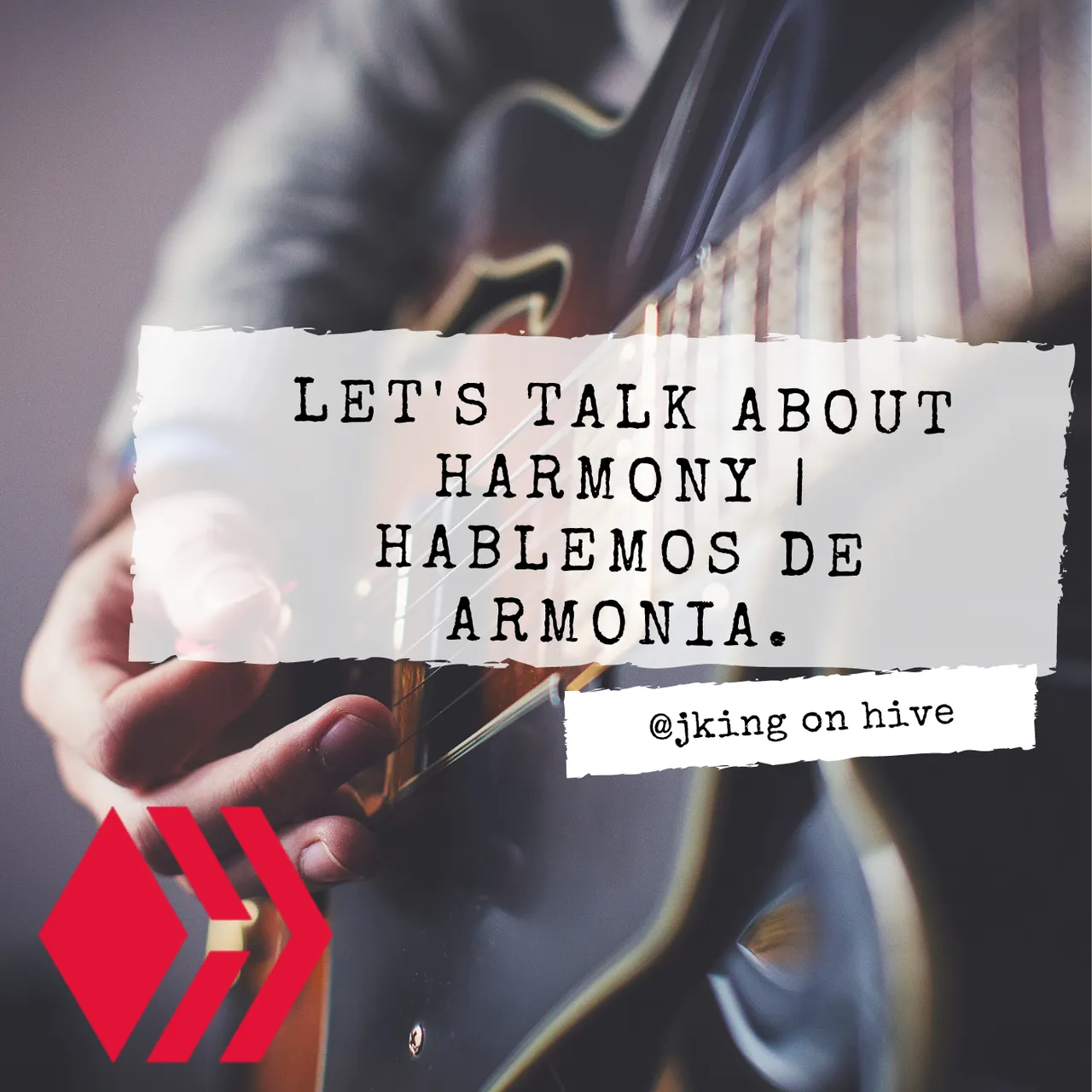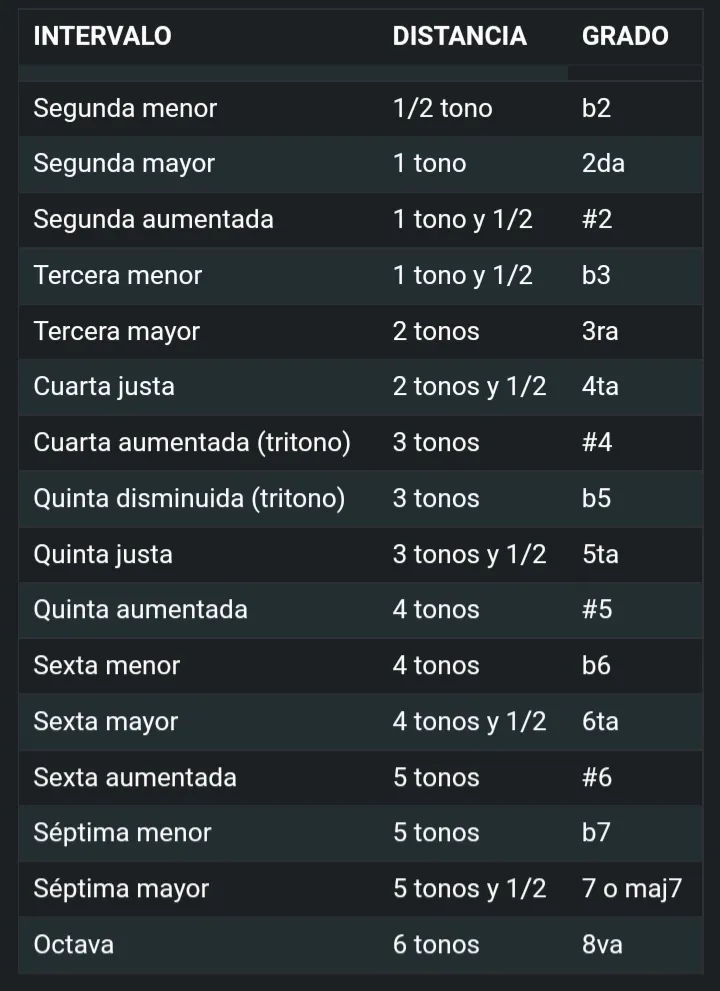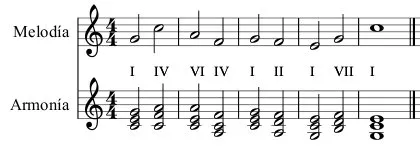
Image created by me in Canva / imagen creada por mi en Canva.

Hello friends, I hope you had an excellent weekend, today I want to start the week with a new initiative that I had in mind for a few days, and that is that I want to talk with you in this community about fundamental aspects of musical Harmony.
Harmony, like melody and rhythm, are the pillars of music, the 3 combined make or integrate the art of music, so I have allocated this space to begin to deal with you with specific aspects and bases of harmony.
Many times we read about music and we do not understand the context, or it is difficult for us to understand what it means, so I have decided to write the concepts the way I learned it, as I analyzed and internalized it, since I consider it to be a very practical and simple way.
One point to remember is that in music as in other arts or sciences, each person generates their learning methods, not all of us in music learn in the same way, the important thing is that in the end the different interpretations or ways of seeing an objective lead us to a common end.
To begin with, what we must define is the concept of Harmony.
What is musical harmony?
For me, musical harmony is nothing more than the branch of music that is responsible for the study of the relationship of two or more notes that sound simultaneously (Interval and Chords), when we talk about a set of notes that sound simultaneously we immediately refer to what is Harmony.
And from here comes the difference to the concept of MELODY; The melody could be defined as a set of notes that go in a way (Linear or Horizontal) which is heard as a single structure; unlike the harmony that contains different structures (Union of 2 or more notes).
Another way of knowing or differentiating the harmony from the melody is that the harmony is written vertically (Because they are groups of simultaneous notes) while the melody is written horizontally (linear form).

Hola amigos, espero que hayan tenido un excelente fin de semana, yo hoy quiero comenzar la semana con una nueva iniciativa que tenía en mente desde hace algunos días, y es que quiero hablar con ustedes en esta comunidad sobre aspectos fundamentales de la Armonia musical.
La Armonia al igual que la melodia y el ritmo, son los pilares de la música, los 3 combinados hacen o integran el arte de la música, así que he destinado este espacio para comenzar a tratar con ustedes aspecto puntuales y bases de la armonia.
Muchas veces leemos sobre música y no entendemos el contexto, o se nos hace difícil de comprender lo que quiere decir, así que yo he decidido redactar los conceptos de la manera en que yo lo aprendí, como yo lo analicé y lo internalice, ya que considero que es una manera muy práctica y sencilla.
Un punto que hay que recordar es que en la música como en otras artes o ciencias, cada persona genera sus métodos de aprendizaje, no todos en la música aprendemos de la misma manera, lo importante es que al final la distintas interpretaciones o formas de ver un objetivo nos lleven a un final en común.
Para comenzar lo que debemos definir es el concepto Armonía.
Que es la armonía músical?
Para mi, la armonia musical no es más que la rama de la musica que se encarga del estudio de la relación de dos o más notas que suenan simultáneamente (Intervarlo y Acordes), cuando hablamos de un conjunto de notas que suenan simultáneamente inmediatemente hacemos referencia a que es Armonia.
Y de aquí parte la diferencia al concepto de MELODIA; La melodia podría definirse como un conjunto de nota que van de manera (Lineal u Horizontal) la cual se escucha como una sola estructura; a diferencia de la armonia que contiene diferentes estructuras(Union de 2 o más notas).
Otra manera de conocer o de diferencia la armonía de la melodía, es que la armonía se escribe de forma vertical(Porque son grupos de notas simultáneas) mientras que la melodia se escribe horizontal(forma lineal).
In the first system of the staff we see the melody and in the second we see the harmony, in this way it is written and in this way it is heard.
Now, a fundamental aspect within the harmony are the so-called "INTERVALS".
What are the intervals?
The intervals is nothing more than the space or the distance that there is from one musical note to another.
What are the intervals for?
It is practically the basis of the harmony, it is like the numbers in mathematics, the intervals are mathematical, they will help us to form the chords, to understand the degrees of tonality, basically they will facilitate everything within the harmony.
Here is a table where I write down the intervals, how the degree is written and how many tones or half tones (Semitones or 1/2) must exist to call it somehow.
En el primer sistema del pentagrama vemos la melodia y en el segundo vemos la armonía, de esta manera se escribe y de esta manera se oye.
Ahora bien, un aspecto fundamental dentro de la armonia son los llamados "INTERVALOS".
Que son los intervalos?
Los intervalos no es más que el espacio o la distancia que hay de una nota musical a otra.
Para que sirven los intervalos?
Prácticamente es la base de la armonia, es como los números en la matemática, los intervalos son matemáticas, nos ayudarán a formar los acordes, a entender los grados de la tonalidad, básicamente nos facilitarán todo dentro de la armonia.
Aquí les dejo una tabla donde les anote los intervalos, como se escribe el grado y cuantos tonos o medio tono(Semitonos o 1/2) debe existir para llamarlo de alguna manera.

Table Created by me / Tabla creada por mi.
But let's take this to the practical part to make it clearer:
I want to analyze what INTERVAL there is from C to G. We do this exercise:
|Do-do#-re-re#-mi-fa-fa#-sol |
----------\ /-------\ /------\ /--------|
----------1t--------1t--------1t------1/2 = (3t and 1/2)
Here we already realized that from C to G, there are 3 and 1/2 tones, we go to the table and we can see that the interval that contains 3t and 1/2 is that of " PERFECT FIFTH"
Pero llevemos esto a la parte práctica para que quede más claro:
Quiero analizar que INTERVALO que hay de Do a Sol. Hacemos este ejercicio:
|Do-do#-re-re#-mi-fa-fa#-sol |
----------\ /-------\ /------\ /--------|
----------1t--------1t--------1t------1/2 >= (3t and 1/2)
Aquí ya nos dimos cuenta que de Do a Sol, hay 3 tonos y 1/2, nos vamos a la tabla y podemos ver que el intervalo que contiene 3t y 1/2 es el de "QUINTA JUSTA"
If we look closely at the table, we see that there are intervals that have the same distance but with different names.
How do I know what name to give if they have the same distance? We will learn this later when we see the formation of the Source Scales.
Si observamos bien la tabla, vemos que hay intervalos que tienen la misma distancia pero con diferentes nombres.
Como se cual nombre darle si tienen la misma distancia? Esto lo aprenderemos más adelante cuando veamos la formación de las Escalas fuentes.
Let's take another example but now in a descending way. Descending interval from C to G.
|Do-si-la#-la-sol#-sol|
--------\ /------\ /--------|
---------1t-------1t------1/2 t = (2 1/2 tones)
We go to the table of intervals and we realize that when there are 2 tones and 1/2 of distance between two notes (It does not matter if it is ascending or descending) it is considered an interval of (PERFECT FOURTH).
Pongamos otro ejemplo pero ahora de forma descendente. Intervalo descendente de Do a Sol.
|Do-si-la#-la-sol#-sol|
--------\ /------\ /--------|
---------1t-------1t------1/2 t = (2 1/2 tonos)
Vamos a la tabla de intervalos y nos damos cuenta que cuando hay 2 tonos y 1/2 de distancia entre dos notas(Sin importa si es ascendente o descendente) se considera un intervalo de (CUARTA JUSTA).
It is important to practice and memorize the intervals both ascending and descending, believe me this is vital for the understanding of harmony.
I hope you liked it .. we will read in the next post.
God bless you.
Espero les haya gustado.. nos leemos en el próximo post.
Bendiciones.


